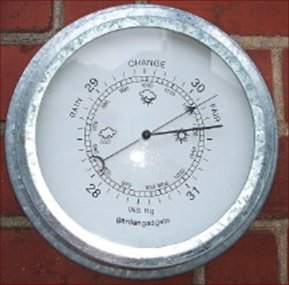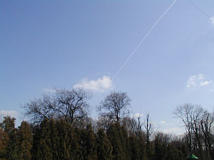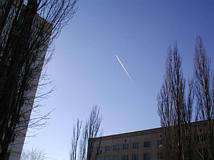Glossary - Clouds Protocol
Glossary
A | B | C | D | E | F | G | H | I | J | K | L | M | N | O | P | Q | R | S | T | U | V | W | X | Y | Z
A
aerosols - Liquid or solid particles suspended in the atmosphere. Their sizes generally have linear dimensions in the range of 100-1000 nanometers (nm). In the earth's atmosphere, common aerosols are dust blown up from deserts, volcanic aerosols, sea salt over and near the oceans, and pollution.
air mass - A large volume of air (often covering thousands of square kilometers) with temperature and humidity characteristics that vary little horizontally.
algorithm - A mathematical relation between an observed quantity and a variable used in a step-by-step mathematical process to calculate a quantity.
altimeter - A barometer, normalized to standard pressure, temperature and density, used to measure altitude by measuring atmospheric pressure. Altitude is determined by assuming all changes in pressure are due to a change in height relative to sea level. Altimeters are adapted to work over wide ranges of height above sea level and used in GLOBE to measure barometric pressure at elevations above 500 meters. Altimeters are also used by airplane pilots to figure out where they are.
altitude - Height above the Earth's surface.
atmosphere - The air surrounding the Earth, described as a series of shells or layers of different characteristics.
atmospheric pressure - The amount of force exerted over a surface area, caused by the weight of air molecules above it. As elevation increases, fewer air molecules are present. Therefore, atmospheric pressure always decreases with increasing height.
B

C
Celsius scale - A temperature scale invented in 1742 by Swedish astronomer Anders Celsius. This scale defines the melting point of water ice as 0° C, and the boiling point of water as 100° C. Because of the 100-degree interval between these two points, this scale is sometimes called the "centigrade scale".
cirriform - A cloud type formed of ice crystals at high altitudes (greater than 6 km above sea level) which looks wispy or like a paintbrush stroked across the sky.
cirrus - A high cloud made of ice crystals. Often thin, white, and in narrow bands.
climate - The average weather conditions is an area determined over a period of years. For example, the climate in Alaska is colder than the climate in Florida, although on any given day the weather might be quite similar.
cloud cover - The percentage of the sky covered by clouds.

condensation - The change of phase of a substance from a vapor to a liquid. This is the opposite of evaporation. The process of condensation releases energy; this energy is known as latent heat.
contrails - (condensation trails) Human-caused clouds formed due to the exhaust of jet aircraft.
D
deposition - The process by which water vapor turns directly into ice on a surface without passing through the liquid phase.
dew point temperature -The temperature to which air must be cooled for condensation to begin, assuming there is no air pressure or moisture content change. At that temperature dew begins to form, and water vapor condenses into liquid. Dew point temperature is a measure of the amount of water vapor in air.
dry bulb temperature - The temperature on one of two thermometers on a sling psychrometer; this temperature corresponds to the bulb which does not contact the water-saturated wick.
E
elevation angle - The angular distance between the horizon and an object in the sky, such as the sun. The zenith angle is 90° minus the elevation angle.
evaporation - Change from a liquid (more dense) to a vapor or gas (less dense) form. When water is heated it becomes a vapor that increases humidity. Evaporation is the opposite of condensation.
F
Fahrenheit scale - A temperature scale invented by the 18th century German physicist Daniel Gabriel Fahrenheit. This scale defines the melting point of water ice as 32° F and the boiling point of water as 212° F. The United States is the only major country in the world still commonly using the Fahrenheit scale.
G
Greenwich Mean Time (GMT) -The same reference time as Universal Time (UT); the time at 0 degrees longitude (the prime meridian) that passes through Greenwich, England.
H
humidity - The amount of water vapor in the air. The higher the temperature, the greater the number of water molecules the air can hold. For example: at 15 degrees C a cube of air one meter on each side can hold up to 0.17 milliliters of water. At 40 degrees C the same cube of air can hold up to 0.70 milliliters of water.
hygrometer - An instrument used to measure the relative humidity of air.
M
mesosphere - The third layer of the atmosphere above Earth's surface, generally found between altitudes of 50 km and 80-85 km and characterized by temperature decreasing with altitude.
P


precipitable water - The depth of the layer of liquid water that would be formed if all the water vapor in a column of atmosphere were condensed onto Earth's surface. On average, the atmosphere contains about 2 centimeters of precipitable water.
R
relative humidity - Relative humidity describes the amount of water in the air compared with how much the air can hold at the current temperature. Example: 50% relative humidity means the air holds half the water vapor that it is capable of holding; 100% relative humidity means the air holds all the water vapor it can. At 100% humidity, no more evaporation can occur until the temperature rises, or until the water vapor leaves the air through condensation. Absolute humidity is the ratio of the mass of water vapor present in a system of moist air to the volume occupied by the mixture, that is, the density of water vapor.
S
satellite - A free-flying object that orbits the Earth, another planet, or the sun.

sling psychrometer - A device consisting of two thermometers, one of which has a dry bulb (normal thermometer) and the other of which has a bulb that is kept wet (by placing a wet fabric sleeve over the reservoir at the base of the thermometer). The difference between the wet and dry bulb temperatures is used to calculate relative humidity.
station pressure - The true atmospheric pressure, uncorrected to standard conditions at sea level. For example, if you live in the Rocky Mountains, there is less air pressing down on you and the station pressure is lower than at Sea Level. Weather reports generally give barometric pressure corrected to sea level, not station pressure, because this would always show a low pressure area over the mountains, and would make it harder to see the changes in pressure which drive weather systems.
stratosphere - The second layer of the atmosphere above Earth's surface, generally characterized by temperature increasing with altitude. The stratosphere begins at altitudes ranging from about 8 km in the polar regions to 16-18 km in the tropics and extends up to altitudes of about 50 km where there is a local maximum in atmospheric temperature. The stratosphere contains most of the ozone found in the atmosphere.
T

troposphere - The lowest layer of the atmosphere where almost all weather occurs. The troposphere contains about 80% of the atmosphere's mass and is characterized by temperatures that normally decrease with altitude. The boundary of the troposphere and the stratosphere depends on latitude and season. It ranges from as low as 8 km over the poles to as high as 16-18 km in the tropics.
U
Universal Time (UT) - The time at 0 degrees longitude (the prime meridian); UT is the currently preferred term for this reference time, which is similar to GMT.
V
visibility - The distance over which an observer can see and clearly identify an object.
W
water vapor - The colorless, odorless, invisible, gaseous form of water in the atmosphere.
weather - The state of the atmosphere at a particular place and time. Weather includes variables such as temperature, barometric pressure, wind, cloudiness, precipitation, and relative humidity.
wet bulb depression - The difference between the dry bulb and wet bulb temperature readings on a sling psychrometer.
web bulb temperature - The temperature taken on a sling psychrometer from the thermometer with its bulb covered in a wet wick (piece of fabric), after slinging or whirling the psychrometer for the prescribed amount of time.
wind - A natural motion of the air, especially a noticeable current of air moving in the atmosphere parallel to the Earth's surface.
Z
zenith angle - The angular distance between an object in the sky, such as the sun, and an object directly overhead. Zenith angle is 90° minus the elevation angle.





